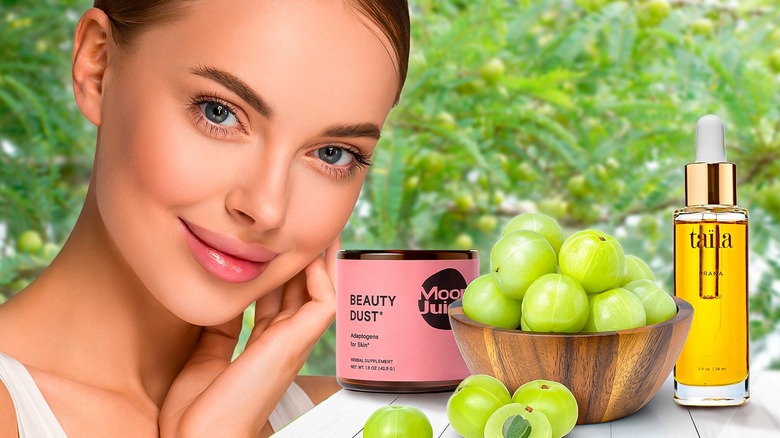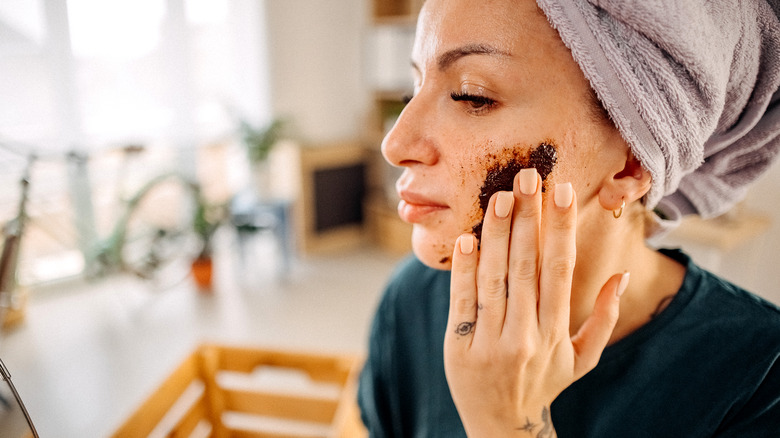5 Benefits Amla Extract Can Have On Your Skin
Are you tired of adding several different chemicals and serums to your face? If so, then maybe it's time to take your skincare routine to more natural levels. It would be nice if you could find a product that worked to hydrate your face and clear up your acne outbreaks. Well — you actually can, and it's been around for centuries.
Amla, also known as Indian gooseberry, are berries from a medicinal plant found in India. The anti-aging extracts collected from amla can be ingested or used topically on the skin. "Amla is known to have strong antioxidant properties since it is rich in ascorbic acid — which we tend to recognize as vitamin C," Samar Kullab, a Chicago-based registered dietitian, tells Byrdie. And that vitamin C is excellent for brightening the skin and fighting sun damage.
In addition to its many benefits to the skin, amla is praised for supporting strong, healthy hair growth, liver function, and heart and gut health (via Healthline). The benefits of amla aren't missed by many, with #amla collecting over 88 million views on TikTok. Let's see what all the rave is about by looking at five different benefits of amla for the skin.
Amla can brighten the skin
Bright, glowing skin is the dream. It's why you typically shell out a small fortune in creams, serums, and cleansers. But sometimes, you need to look at ancient medicine for brightening your skin and helping with hyperpigmentation.
As noted, amla is packed with vitamin C and antioxidants, which your skin craves. It can also boost procollagen production, according to a 2008 study by The Journal of Ethnopharmacology. In addition to making your skin naturally glow without an Instagram filter, those dark spots and hyperpigmentation can start to fade naturally, evening out your skin tone while making your face supple and radiant.
Reaching for powdered amla extract and creating your own DIY face mask with honey and hibiscus is a great place to start for the ultimate skin-brightening treatment. Mix one hibiscus flower with 1 teaspoon of honey and 2 tablespoons of amla powder to make a thick paste. Apply this to your face for about 20 minutes. You'll notice a difference as the vitamin C in both the amla and hibiscus flower works its magic on your pores and skin tone. Brightening is one of the big positives when adding amla to your skincare routine, but it's also an age-fighting ninja.
Anti-aging properties of amla
It might be hard to believe that a few berries are the key to opening up the fountain of youth for your skin. Unlike many other natural remedies, amla has the research to back it up. According to a 2016 Pharmaceutical Biology study, amla worked to inhibit collagenase, which breaks down the collagen in your skin. By inhibiting them, this precious plant can give you plumper and tighter skin. And the antioxidant level is off the charts, adding to this product's anti-aging magic.
Everyone knows that collagen is helpful in keeping your skin looking youthful. Plump skin works to erase those fine lines and wrinkles. You may also notice what appears to be a reduction in the size of your pores. While amla or any other product isn't going to shrink your pores, the smooth palette of your face can give the appearance of smaller pores and more perfect-looking skin. Hello, youthful glow! While you can use the same mask recipe to get the anti-aging effect of amla, incorporating the oil into your nighttime skincare routine can be a one-two punch against the effects of aging.
Amla has skin-protecting properties
Too much sun exposure is bad for your skin. Sure, it gives you that beautiful golden glow, but the glow comes at a cost as the UV rays and free radicals wreak havoc on the internal workings of your body. Too much sun can lead to premature aging and even cancer. But don't worry: Amla has your back in the skin protection department. Board-certified dermatologist Ranella Hirsch told Byrdie, "Amla's potent antioxidants address the free radicals created from environmental stresses like pollution and UV rays."
Additionally, a 2021 study in Antioxidants supports amla "as an active ingredient for skin protection from UV irradiation," specifically "UVB-induced oxidative stress" — aka the UV rays that mainly cause sunburn and "most skin cancers," as noted by the American Cancer Society. There's a reason that amla has been used throughout the centuries for natural skincare! However, it's still important to remember to apply sunscreen and cover up your face with a hat. For that golden look, try a fake tanner rather than baking in the sun.
Use amla to keep your skin clear
It can feel like you've tried everything under the sun to help the inflammation, breakouts, and scarring that comes with acne. Many people also aren't hip about adding many different chemicals to their faces. Add amla to your treatment routine since it's great for wound healing and helping to rejuvenate the skin, according to the International Journal of MediPharm Research. Additionally, the brightening effect and the way the antioxidants work against inflammation means it may help reduce the look of acne scars.
To harness the pimple prevention of Indian gooseberry, it's easy to create a simple paste with amla powder and water. You might also want to add a bit of apple cider vinegar to the mix since it restores the pH balance of your skin and can reduce hyperpigmentation. Use this as an all-over face mask, or use it for spot treatment. It may also be beneficial to add amla to your diet for acne as well, helping the body from the inside out.
Gently exfoliate the skin by adding amla to your routine
Removing dead skin cells from your skin can make your complexion look brighter. However, exfoliating according to your skin type is key since it can be a little harsh for certain people. According to the American Academy of Dermatology, exfoliating can do more harm than good for sensitive skin, giving a burning sensation after use.
Thankfully, amla offers a gentle exfoliation that can hydrate and protect your skin while releasing the power of a fresh, brighter face. The Times of India notes that the antioxidants and vitamin C in the amla extract make for an excellent exfoliator, helping "to tone, tighten the skin, and make it firm."
To create the amla exfoliant, mix amla powder with a bit of water and gently scrub your face with a cloth or fingers. The juice can also be used as a cleanser to gently remove dirt, oil, and dead skin. Just listen to your skin and only use the pressure and motion necessary to slough that skin away. Nevertheless, whether you use amla as a scrub, a facemask, or even ingest it, your body — and skin — will have the opportunity to reap the rewards.


